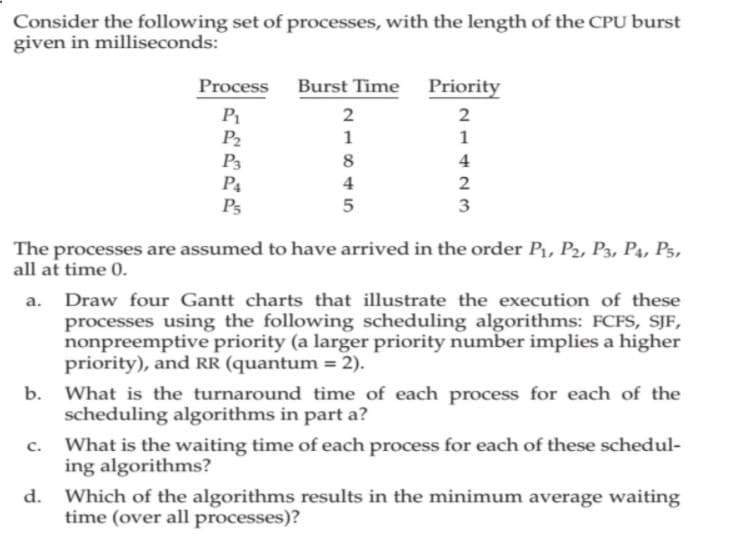Consider the following set of processes, with the length of the CPU burst given in milliseconds: TTT Process Burst Time Priority 2 2 P2 P3 P4 P5 1 1 8 4 4 2 5 3 The processes are assumed to have arrived in the order P, P2, P3, P4, P5, all at time 0.
Consider the following set of processes, with the length of the CPU burst given in milliseconds: TTT Process Burst Time Priority 2 2 P2 P3 P4 P5 1 1 8 4 4 2 5 3 The processes are assumed to have arrived in the order P, P2, P3, P4, P5, all at time 0.
Computer Networking: A Top-Down Approach (7th Edition)
7th Edition
ISBN:9780133594140
Author:James Kurose, Keith Ross
Publisher:James Kurose, Keith Ross
Chapter1: Computer Networks And The Internet
Section: Chapter Questions
Problem R1RQ: What is the difference between a host and an end system? List several different types of end...
Related questions
Question

Transcribed Image Text:Consider the following set of processes, with the length of the CPU burst
given in milliseconds:
Process
Burst Time
Priority
P1
P2
P3
P4
Ps
2
2
1
1
8
4
4
2
5
3
The processes are assumed to have arrived in the order P1, P2, P3, P4, P5,
all at time 0.
a. Draw four Gantt charts that illustrate the execution of these
processes using the following scheduling algorithms: FCFS, SJF,
nonpreemptive priority (a larger priority number implies a higher
priority), and RR (quantum = 2).
b. What is the turnaround time of each process for each of the
scheduling algorithms in part a?
What is the waiting time of each process for each of these schedul-
ing algorithms?
с.
d. Which of the algorithms results in the minimum average waiting
time (over all processes)?
Expert Solution
This question has been solved!
Explore an expertly crafted, step-by-step solution for a thorough understanding of key concepts.
This is a popular solution!
Trending now
This is a popular solution!
Step by step
Solved in 3 steps with 3 images

Recommended textbooks for you

Computer Networking: A Top-Down Approach (7th Edi…
Computer Engineering
ISBN:
9780133594140
Author:
James Kurose, Keith Ross
Publisher:
PEARSON

Computer Organization and Design MIPS Edition, Fi…
Computer Engineering
ISBN:
9780124077263
Author:
David A. Patterson, John L. Hennessy
Publisher:
Elsevier Science

Network+ Guide to Networks (MindTap Course List)
Computer Engineering
ISBN:
9781337569330
Author:
Jill West, Tamara Dean, Jean Andrews
Publisher:
Cengage Learning

Computer Networking: A Top-Down Approach (7th Edi…
Computer Engineering
ISBN:
9780133594140
Author:
James Kurose, Keith Ross
Publisher:
PEARSON

Computer Organization and Design MIPS Edition, Fi…
Computer Engineering
ISBN:
9780124077263
Author:
David A. Patterson, John L. Hennessy
Publisher:
Elsevier Science

Network+ Guide to Networks (MindTap Course List)
Computer Engineering
ISBN:
9781337569330
Author:
Jill West, Tamara Dean, Jean Andrews
Publisher:
Cengage Learning

Concepts of Database Management
Computer Engineering
ISBN:
9781337093422
Author:
Joy L. Starks, Philip J. Pratt, Mary Z. Last
Publisher:
Cengage Learning

Prelude to Programming
Computer Engineering
ISBN:
9780133750423
Author:
VENIT, Stewart
Publisher:
Pearson Education

Sc Business Data Communications and Networking, T…
Computer Engineering
ISBN:
9781119368830
Author:
FITZGERALD
Publisher:
WILEY